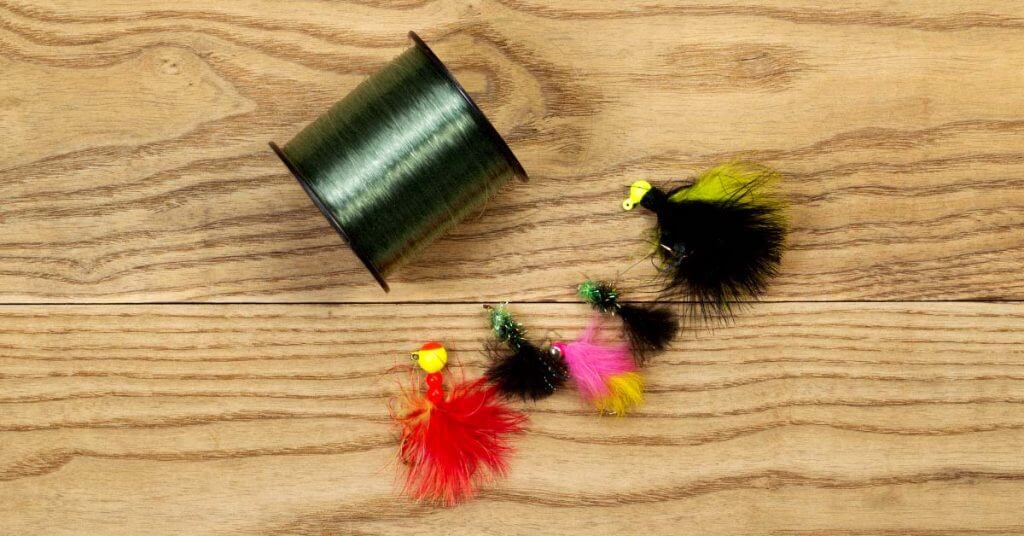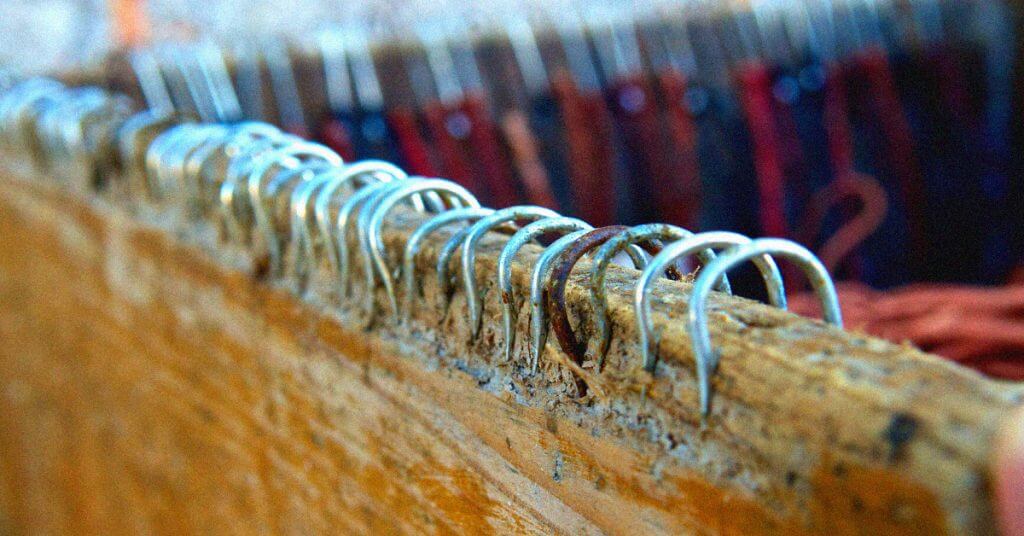Bass fishing is unquestionably one of the most popular interests for those who love fishing.
The significant challenges involved in reeling in nice bass is one of the key reasons why many people prefer to fish for bass.
But due to the vast amounts of knowledge required, the sport of bass fishing can be intimidating for beginners.
If you’re interested in scratching that surface itch, it’s best to start by learning more about the activity, a little about required gear and how that information can enhance your enjoyment and likelihood of catching that big game fish.
At times, it seems like bass fishing boasts more terminology than even baseball!
In some instances, even lifetime professional anglers don’t necessarily know what every term or do-hicky means.
Too often, people are afraid or embarrassed of asking questions about bass fishing and that’s a huge mistake.
It can be daunting at first with so much information out there on of arrangements of rods, reels, lures, and fishing lines, not to mention hooks, sinkers, and bobbers.
We would rather you give it a try, gain some experience and enjoy the sport as you grow in your knowledge.
So let’s begin with some answers to basic questions.
But, keep in mind that there is no one perfect setup, piece of gear or technique that works for every person or situation.
Trial and error are part of the fun and if you’re not having fun, you’re doing it wrong.
What Size Hooks For Bass Fishing
In the YouTube video above YourBassGuy.com content creator Wes Littlefield explains how to choose the right hooks for fishing.
One of the most common questions when it comes to bass fishing has to do with picking the right size hook.
How do you know which size is the best for bass fishing? Do you need different sizes in your tackle?
When it comes to bass fishing, hook sizes for might seem complex. The fact that both freshwater hooks and sea hooks utilize the same scale system brings about this misunderstanding.
The general rule of thumb is that the larger the number of a hook, the smaller the actual size of the hook. The hook sizes start at 32 and progress to 1 getting bigger and bigger as they go.
Hooks are measured by the number and ought sizes. Number hooks are designated as No. 1, No. 2, No. 4, etc.
The basic rule of thumb is that a No. 1 hook is 3 sizes larger than a No. 4 hook. And a No. 4 hook is two sizes larger than a No. 6 hook and so on.
On the contrary, after No. 1 hooks are measured as 1/0, 2/0, 3/0, etc. These “ought hooks” are the opposite of the No. hooks in that a 1/0 hook is smaller than a 3/0 hook and a 3/0 hook is smaller than a 6/0 hook.
So if someone says they had on a No. 6 hook. That is a petite hook compared to a 6/0 hook.
Most commonly, for largemouth and smallmouth bass fishing, the suitable sizes are 6/0, 5/0, 4/0, 3/0, 1/0, 1, 2, and 4. Certainly, the size depends on the technique of the angler using it.
What Type Of Fishing Line For Bass
Wes Littlefield, content creator for YourBassGuy.com, explains how to choose the right fishing line.
What pound test line should I use?
Much like other questions in fishing, the answer to this one is complicated yet simple at the same time: it’s subjective.
Let’s look at a quick rundown of which line to use for which baits.
- Monofilament: work best with topwaters, Texas-rigged soft plastics, jigs, crankbaits, spinnerbaits, swimbaits.
- Fluorocarbon: perform great with Texas-rigs, Carolina-rigs, wacky-rigs, shaky head, jigs, tubes, buzz baits, crankbaits, spinnerbaits, jerk baits, swimbaits.
- Braided: do well with frogs, toads, buzz baits, topwaters, jigs, Texas-rigs, Alabama-rigs, flipping jigs.
You will notice that there are a lot of overlapping baits. Case in point, you can use a crankbait on fluorocarbon or monofilament line, it has more to do with partiality.
Remember, these pairings are just suggestions of what traditionally works best. If you like to fish with a braid and spinnerbaits because it aids you ripping it free from the grass, go for it.
When it comes to testing on bass spinning reels, usually anything over 10-12lb monofilament or fluorocarbon is too heavy, impacting the performance of the reel and the bait.
Since spinning reels are generally used with lighter baits and more finesse, a good rule of thumb is to use a line between 6 and 12lb of monofilament or fluorocarbon and 10 to 30lb braid is solid for spinning rods.
Baitcasting reels are typically used for more heavy or reaction-strike applications. You can use line anywhere from a 10lb to 25lb monofilament or fluorocarbon, and 30lb to 80lb braid line.
What Color Fishing Line Is Best For Bass
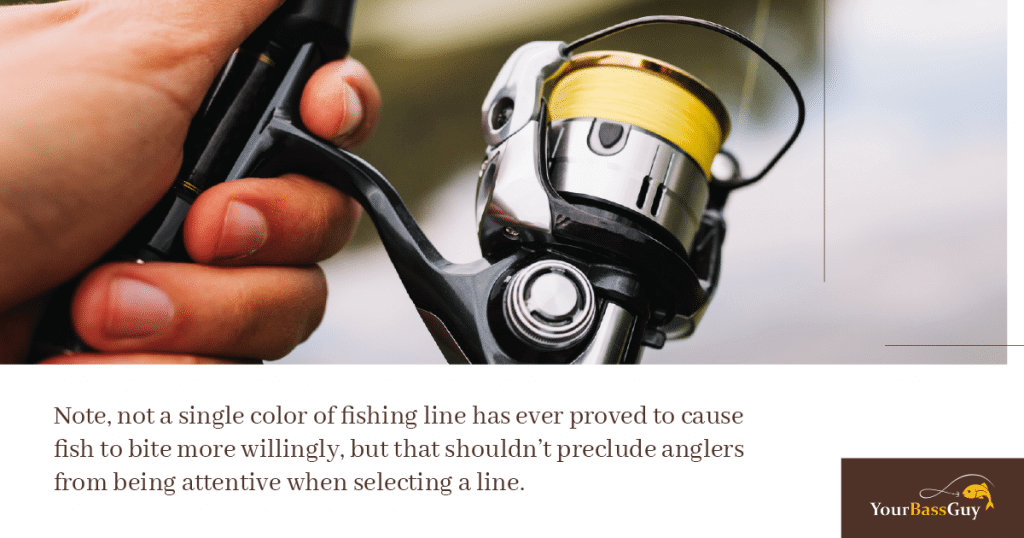
What is the right type and color of line to use for bass fishing?
The answer depends a lot on water clarity, but there are some go-to line colors that work well nonetheless.
Note, not a single color of fishing line has ever proved to cause fish to bite more willingly, but that shouldn’t preclude anglers from being attentive when selecting a line.
When it comes to fishing line colors there are a lot of choices. Manufacturers hype various colors of fishing line as less visible to fish than others.
Having a variety of types and colors of line in your tackle collection is essential. Each line offers certain benefits, and the color of the line certainly plays a strategic role in maximizing your success on the water.
Fluorocarbon lines are highly hyped for the ability to remain practically invisible in all water conditions. That’s one of the reasons (in addition to having the greater abrasion resistance and low stretch) for their higher price tag.
Pink lines fluorocarbon are widely held as they are rapidly absorbed, making it virtually invisible in water.
However, as fluorocarbon is pretty much invisible, to begin with, color is less of a concern with them. But it can play a larger role in other types of lines.
For instance, monofilament lines are available in a wider range of color choices designed to either be harder for the fish to detect or easier for the angler to see, example: hi-vis fishing line.
Here’s an analysis of how colored monofilament may impact your fishing:
- Red– Red is the first color to lose its light underwater, red becomes imperceptible underwater yet is easier to see above water. Great for use with spoons, plastics or almost any live bait.
- Green– Green blends well into the water, making the line harder to identify underwater, with most water featuring greenish hues and vegetation. A versatile, all-around fishing line of choice that is good for various water environments.
- Yellow– Yellow is ideal for those dirtier water conditions, it’s easy for the angler to see above water and lets you detect bites better, although it is more evident in clear waters.
If you’re going to fish with braided line, keep in mind that although braid has several benefits over monofilament, with a higher strength-to-diameter ratio being one of them, it is also going to be more visible to bass in the water.
What Type Of Hook For Bass Fishing
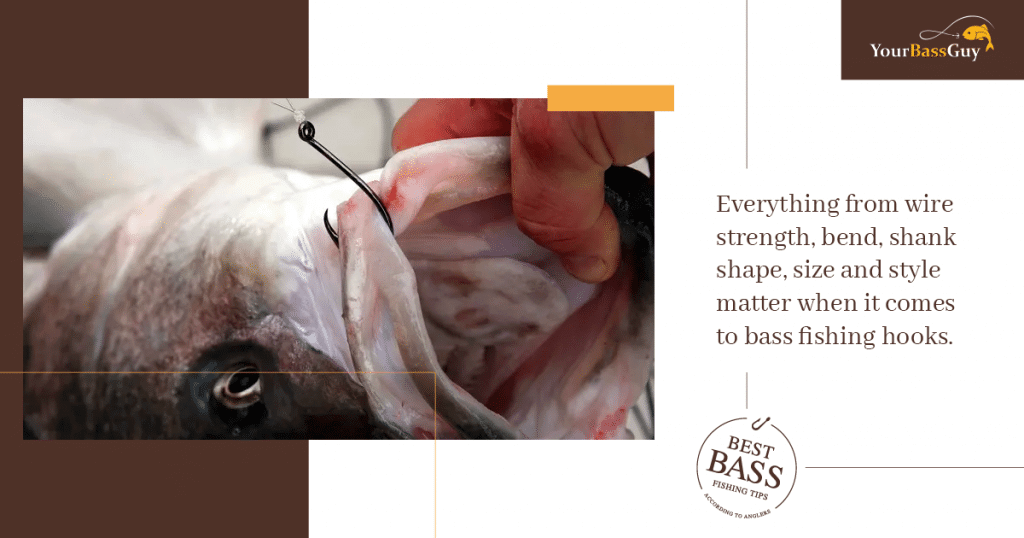
Probably the most significant piece of terminal tackle in your kit would be fishing hooks.
This is the key factor to be able to snare a nice bass that bites and hopefully land the fish.
Everything from wire strength, bend, shank shape, size and style matter when it comes to bass fishing hooks.
To keep it simple a hook is a strong piece of stainless steel, bronze or other metal sharpened on the point with an eye to attach the hook to a lure or to tie the line to directly when bass fishing.
For all intents and purposes you have three types of hooks for bass fishing. They are treble hooks, worm hooks and live bait hooks.
- Treble Hooks– A treble hook is a three-pronged hook that attaches to most hard lures like crankbaits, topwaters, jerk baits, and such.
- Worm Hooks– These are basically hooks made for rigging soft plastics in a natural looking arrangement usually in conjunction with some sort of slip sinker.
- Live Bait– Live bait hooks are, as the name infers, intended for rigging live bait to lure bass into biting.
The lighter gauge metal used the more the hook will flex while fighting a bigger fish, but the easier it is to penetrate on a hook set.
The wider the area between the hook point and the shank or eye of the hook, the more “bite” it will have. This simply means there is more hooking area for a bulkier plastic bait to move out of the way on a hookset.
Do You Need A Sinker For Bass Fishing
In the YouTube video above, YourBassGuy.com content creator Wes Littlefield explains how he chooses the right weight every time he goes fishing.
In bass fishing, weights, more often called sinkers, are commonly used with soft plastic lures.
You have bullet weights for Texas rigging, egg sinkers for Carolina rigging, bell sinkers and cylinder sinkers for drop shot, split-shots for finesse fishing, and even clip-on or add on weights for weighting the hooks.
Wait, what? We know that all sounds perplexing and highly technical so let us clarify it a bit.
Sinkers can range in weight from 1/64oz up to a hefty 2oz for most bass fishing applications. The weight often has to do with the depth you want to fish or the density of the hiding place you need to penetrate.
Sinkers that have a hole in them, known as Slip sinkers, are intended to thread your fishing lure through so they can slide up and down the line, and are regularly used for Texas rigging and Carolina rigging.
Bell sinkers and Cylinder sinkers have an eye at the top of the weight designed to tie to the end of your line with a plastic or live bait hook usually tied some space up the line from the weight.
Split shots, on the other hand, can be pinched on your line just above the hook or lure you intend to use to give it a natural slow fall or to keep live bait from swimming up to the surface the entire time.
Sometimes weight is molded or attached to the eye of a hook in a certain shape to form what’s called a jig head. It’s just another way to weight a soft plastic lure and keep it all in one piece more resembling a jig.
You thread the plastic onto the jighead and it fishes more like a jig than a slip sinker or drops shot type of get-up.
If you want an ultra-slow fall on a little finesse plastic in nice clear water, you might pinch a small 1/32-ounce piece of split shot on your line.
If you need to thump your lure through some entwined grass in 10 feet of water, you might want to use a 1-ounce slip sinker to get the bait through the cover and down to the hiding bass underneath.
But, the general rule is to use the smallest amount of weight you can get away with but still feel what your lure is doing.
Caution: The supplementary weight you put on a lure, the more it will want to snag. The lighter the weight, the tougher it is to stay in contact with your lure and feel when something changes, like a fish biting.
If bottom contact is vital, you may need more weight if it’s windy, strong current, and deeper water. Essentially the calmer it is, the lighter weights you’ll need to throw.
How Many Lines Do You Need for Bass Fishing
This query comes up for novices a ton.
Which line, type, color, test are all questions that are dependent on the fishing environment you find yourself in. But, there are some simple to follow guidelines to be aware of before heading out.
When angling for bass, there are three basic types of fishing lines that are typical to use: monofilament, fluorocarbon, and braided.
- Braided – braided lines are mostly used by bass fishers because they don’t stretch and they have absurd tensile strength and abrasion resistance, allowing you to be able to tire and fight that bass out of or through dense cover (like condensed plants or wood).
- Fluorocarbon – are also preferred by many anglers as it is the toughest to see in the water and tends to be very abrasion-resistant as well, giving anglers a tad of an advantage in tempting that bass nibble.
- Monofilament – which used to be the most commonly casted type of line for many years, may possibly have come to be less popular because of increased innovations behind the other two types above, but it is without a doubt still being used by many anglers because of its stretch aspect.
Several veteran anglers like using a combination of different types of line to provide a little bit more stretch and lessen the risk of fish shaking the hook, so they add a monofilament or fluorocarbon leader to a braid.
One main note, a good quality fishing line is not going to be cheap and whichever line you decide to go with, it will have to be no less than 300 yards as bass fishing involves long casts and extended runs.
Also, if you’re going to purchase a line with a matching spool, be sure it works with the reel you will be using. Read the label and you should be able to find the line capacity listed on the spool itself.
Finally, it’s essential to know a fishing line’s “pound test”, this indicates the weight of pressure it can withstand before breaking.
For bass fishing, you’ll need to go with a stronger line, so you’ll want to use at least an 8lb test line at a minimum and go up from there.
Our advice would be to bring a few lines in different colors, test, and types in your tackle and do your best to match the line to the situation you find yourself.
Ask around to get an idea of what others are using in the area and if the first line is a bust switch it out and give another one a try.
Conclusion
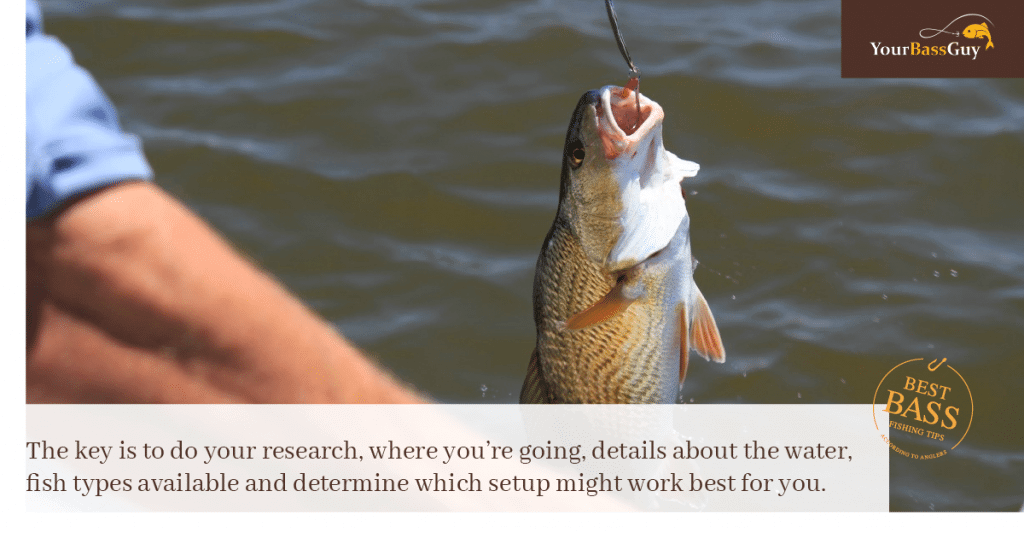
The information above should give you a decent start and some good ideas about the main types of gear (lines & hooks) that you can practice with when you make the decision to go fishing for bass.
It’s true it can get overwhelming with such a large range of combinations of rods, reels, lures, and lines that are out on the market for bass fishing, not to mention hooks, sinkers, and bobbers and how to properly use all that newly discovered tackle.
Don’t let that deter you from a very enjoyable pastime. The key is to do your research, where you’re going, details about the water, fish types available and determine which bass fishing techniques might work best for you.
Let us know if you have any questions or feedback in the comment section. Get out there, cast your line and enjoy the experience and maybe we will see ya out on the water.

